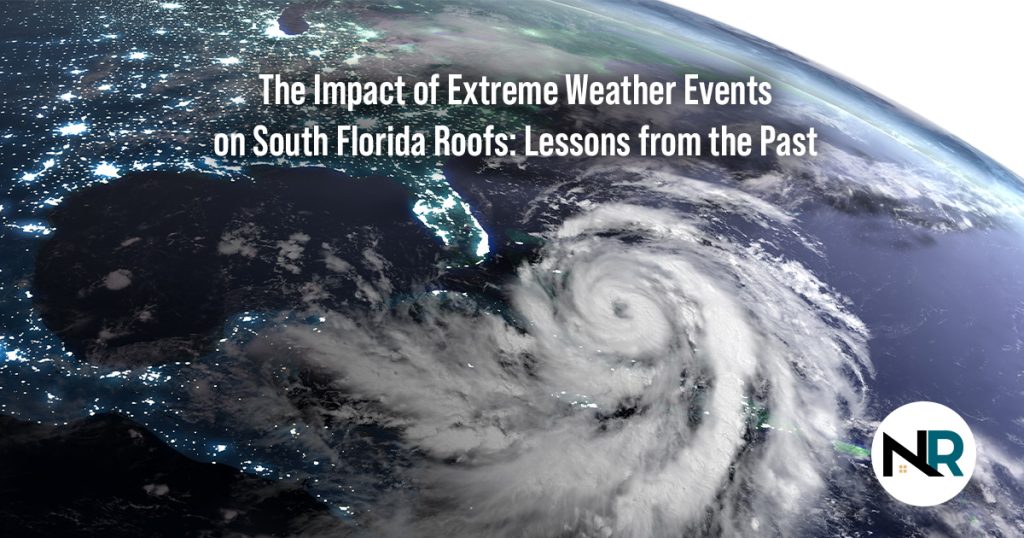As a roofing contractor serving South Florida for over 25 years, Native Roofing has witnessed the devastating effects of extreme weather events on roofs. In particular, storms like Hurricane Andrew have left a lasting impact on the region’s buildings and infrastructure.
In this blog post, we’ll delve into the lessons learned from past extreme weather events in South Florida, emphasizing the importance of proactive measures and durable roofing solutions to withstand future weather events.
- Hurricane Andrew: One of the most significant extreme weather events in South Florida’s history is Hurricane Andrew, which struck in August 1992. The Category 5 hurricane caused widespread destruction, including severe damage to roofs in Palm Beach and Broward Counties. The aftermath of this catastrophic event served as a wake-up call for homeowners and roofing professionals alike.
According to Wikipedia, Hurricane Andrew caused approximately $25.3 billion in damage in Florida, with other estimates suggesting that the damage total exceeded $34 billion. The storm resulted in the destruction of more than 63,500 houses and damage to over 124,000 others. Additionally, Hurricane Andrew claimed the lives of 65 people, either directly or indirectly related to the storm.
The devastation caused by Hurricane Andrew left a significant impact on the local community, particularly affecting the roofing industry as many roofs were damaged or destroyed. South Florida roofing companies played a crucial role in the recovery process.
- Recent Tornado Damage & Wind Gusts: As reported in the “Palm Beach Post,” in April of 2023, Palm Beach County experienced a violent EF-2 tornado in Palm Beach Gardens and North Palm Beach. In addition, golf ball-sized hailstones occurred in Jupiter, along with a waterspout in Boca Raton.
More recently, a rare weather phenomenon called a “wake low” took place this past November. The wake low brought powerful gusts and heavy rain, causing wind gusts as high as 75 mph.
- Extreme Heat: The summer of 2023 was particularly notable, with a continuous heatwave that shattered temperature records. Additionally, it was the second hottest year on record for both West Palm Beach and Fort Lauderdale.
Climate scientists attribute these extreme weather events to climate change, and they noted that warmer temperatures and increased humidity have become trends in the area.
Despite an above-active hurricane season with 20 named storms, South Florida managed to evade hurricane impacts. Overall, 2023 was a year of significant weather challenges for South Florida, with record heat, tornadoes, and other impactful events.
Over the years, South Florida has experienced numerous major storms that have taken a toll on roofs. From powerful wind gusts to torrential rainfall, these events have highlighted the vulnerabilities of traditional roofing systems and the need for more robust solutions.
Lessons Learned: Taking a Proactive Approach: The lessons learned from past extreme weather events have emphasized the importance of taking a proactive approach to roof maintenance and upgrades. Here are some key takeaways:
- Regular Inspections: Regular roof inspections are crucial to identify potential weaknesses and address them before they become major issues. Native Roofing recommends scheduling professional inspections at least once a year, preferably before the hurricane season begins each June 1st.
- Wind-Resistant Roofing Materials: South Florida’s roofs must be equipped to withstand strong winds. Investing in wind-resistant roofing materials, such as impact-resistant shingles or metal roofs, can provide an added layer of protection against severe weather events.
- Proper Installation: Ensuring proper installation is essential for the longevity and durability of a roof. Native Roofing’s experienced team follows industry best practices to ensure that each roof is installed correctly, minimizing the risk of damage during extreme weather events.
- Regular Maintenance: Regular maintenance is crucial in preserving the integrity of a roof. This includes clearing debris, checking for damaged or missing shingles, and maintaining proper drainage to prevent water ponding.
- Reinforcing Vulnerable Areas: Some areas of a roof, such as eaves, ridges, and flashings, are more prone to damage during extreme weather. Reinforcing these areas with additional protective measures, such as extra flashing or using impact-resistant materials, can help mitigate potential damage.
Protect Your Roof for the Future
The impact of past extreme weather events in South Florida serves as a reminder that being prepared is the best defense against Mother Nature’s fury. By taking a proactive approach to roof maintenance and investing in durable, weather-resistant materials, homeowners in Palm Beach, Broward, and the surrounding counties can rest easier during hurricane seasons and other severe weather events.
At Native Roofing, we understand the unique challenges that South Florida’s climate presents. We’re ready to assist you with all your roofing needs – from inspections and repairs to re-roofing projects – contact us today at Broward: 954-236-9986 or Palm Beach: 561-469-7930, or visit our website at NativeRoofing.com to request your free roofing quote.
Don’t let the next storm catch you off guard. Secure your roof NOW!


